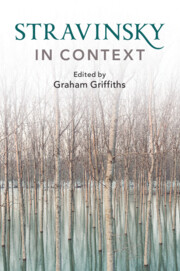Book contents
- Stravinsky in Context
- Composers in Context
- Stravinsky in Context
- Copyright page
- Contents
- Illustrations
- Contributors
- Preface
- Abbreviations
- Frontispiece
- Epigraph
- Part I Russia and Identity
- Part II Stravinsky and Europe
- Part III Partnerships and Authorship
- Chapter 12 Stravinsky’s Sphere of Influence: Paris and Beyond
- Chapter 13 Stravinsky and His Literary Collaborators
- Chapter 14 Assuming Co-authorship: Stravinsky and His ‘Ghostwriters’
- Chapter 15 Nadia Boulanger and Stravinsky: The Transition to America
- Chapter 16 Conversations with Craft
- Part IV Performance and Performers
- Part V Aesthetics and Politics
- Part VI Reception and Legacy
- Recommendations for Further Reading and Research
- Index
- Endmatter
Chapter 14 - Assuming Co-authorship: Stravinsky and His ‘Ghostwriters’
from Part III - Partnerships and Authorship
Published online by Cambridge University Press: 03 December 2020
- Stravinsky in Context
- Composers in Context
- Stravinsky in Context
- Copyright page
- Contents
- Illustrations
- Contributors
- Preface
- Abbreviations
- Frontispiece
- Epigraph
- Part I Russia and Identity
- Part II Stravinsky and Europe
- Part III Partnerships and Authorship
- Chapter 12 Stravinsky’s Sphere of Influence: Paris and Beyond
- Chapter 13 Stravinsky and His Literary Collaborators
- Chapter 14 Assuming Co-authorship: Stravinsky and His ‘Ghostwriters’
- Chapter 15 Nadia Boulanger and Stravinsky: The Transition to America
- Chapter 16 Conversations with Craft
- Part IV Performance and Performers
- Part V Aesthetics and Politics
- Part VI Reception and Legacy
- Recommendations for Further Reading and Research
- Index
- Endmatter
Summary
Discussion of Stravinsky’s so-called ghostwriters usually focuses on Chroniques de ma vie (1935) and Poétique musicale (1939) – two books, originally written and published in French, which the composer produced during the interwar period.1 This is because Stravinsky is presented as the sole author of both volumes even though, strictly speaking, he wrote neither. ‘Ghostwriter’ has become a commonplace to describe those who collaborated with Stravinsky, but the term’s connotations of imposture make it unsuited for describing the composer’s complex relationship with the act of writing, his routine for preparing texts and the workings of what might be called his ‘idea mill’. Stravinsky himself only rarely, and somewhat reluctantly, admitted the important role played by the many co-authors involved in drafting his writings. In turn, his collaborators seem to have accepted the arrangement without hesitation, often as a form of devotion to the composer.
- Type
- Chapter
- Information
- Stravinsky in Context , pp. 125 - 132Publisher: Cambridge University PressPrint publication year: 2020

